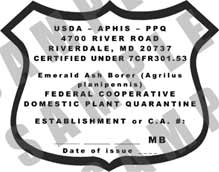Packaged firewood comes in a lot of forms, and it is important for you to know the difference between kiln dried firewood and heat treated firewood.
Kiln dried firewood is firewood that has been dried out, for some unknown period of time at some unknown temperature, in a kiln. It is a term without a firm definition, and with no legal standing. Kilns used for kiln drying can be set to lots of different temperatures and they can dry wood out a little, or a lot, and still label the wood kiln dried. Kiln dried firewood is NOT acceptable to move around, because of huge variations in how long, and how hot, the firewood was treated. It is completely NOT a meaningful label when it comes to forest pests and diseases. You cannot, for instance, take firewood that is simply labeled “kiln dried” out of a quarantined area for emerald ash borer. That is illegal.
Heat treated firewood is different. The makers of heat treated firewood hold a legal compliance agreement that certified the firewood was heated to a certain core temperature and for a certain amount of time. The heat treatment standard that is used most often in the USA is for 60 minutes to 60 degrees Celcius (140 degrees Farenheit) because this is the approved heat treatment level for emerald ash borer. The majority of the time, heat treated firewood is considered OK to move if it is properly labeled as such. There is notably some variation in heat treated firewood and various state and federal regulations. For instance, the required heat treatment level for firewood entering the state of New York is higher (hotter and longer) than the heat treatment level for firewood leaving an emerald ash borer quarantine area. However, in most cases, firewood labeled with a USDA APHIS seal (like the sample shown below) is considered safe to move across jurisdictional boundaries.
In the USA, for firewood to be considered legally certified as heat treated, the certifying entity must be either a state agency with regulatory authority, or the federal agency USDA APHIS. Often, this fully termed certified heat-treated firewood (this is written either with or without the hyphen) and certified heat-treated firewood is the type of firewood that typically is permitted to cross state, international, or quarantine boundaries.
And now you know!

.jpg)




